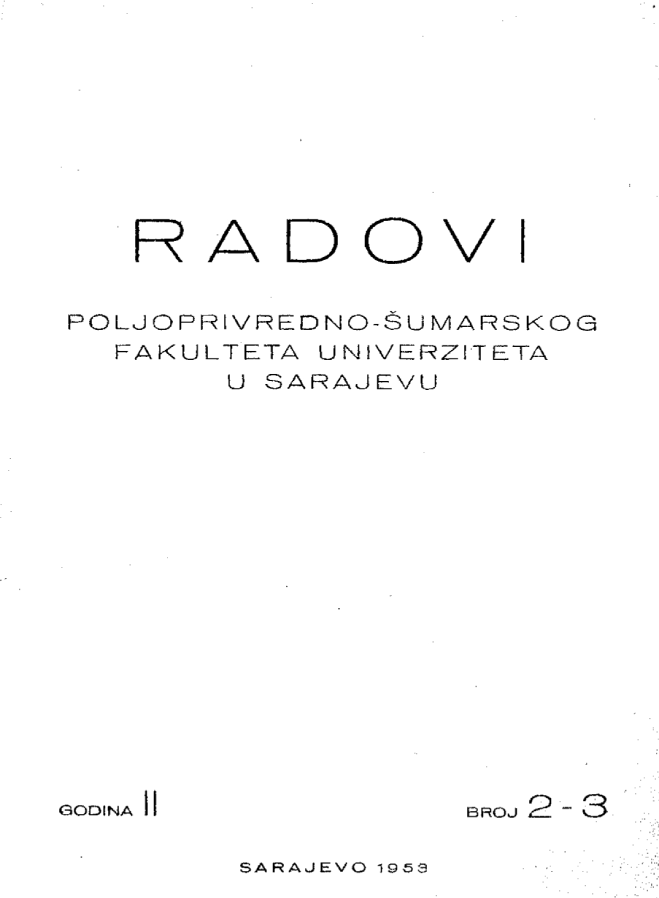ISTRAŽIVANJE INOKOSNIH SELJAČKIH GOSPODARSTAVA
DOI:
https://doi.org/10.54652/rsf.1953.v2.i2-3.322Abstract
On the basis of data available — resulting from a survey undertaken in 1932 — the author presents a report on peasant agriculture in the middle area of the People’s Republic of Croatia (a constituent part of The Federal Peoples’ Republic of Yugoslavia). Of a total of 70 peasant holdings belonging to a village, 39 were made the object of the study. The size of the holdings surveyed varied between 0,2 and 14,6 hectares of cultivated land; most of them, however, wei*e of 2 —-10 hectares.
As a result of the study, the author emphasizes subsistence farming generally prevailing on small-sized holdings of the area. In this system of subsistence farming a great many areas, which were more extensively exploited on larger peasant farms, were used as arable land in the case of smaller farms examined because of the need for production of food for the families concerned.
The average number of family members living on the farms examined ranged from 4 to 5,67. This number tends to rise with the increase in size of the holdings. Hired labor on these family-owned farms was only exceptionally used on all holdings. Individual family members of all holdings under 2 ha in size used to go and look for work elsewhere, prompted by need; this need, grew less, however, with the increase in the size of the holdings. On farms
of over 10 ha there was no need for looking for outside jobs. Investments in buildings, tools, machines and livestock on holdings of various sizes are shown in a series of Tables. A careful analysis of the data available shows a decrease in farm investments per one ha with the growth in size of the farms, yet a clearly defined decrease of investments in buildings and livestock could not be established because of most intensive animal production in the case of farms from 2 to 5 ha in size. On all farms of over 2 ha two cows — with respective young cattle — were kept. as a general rule, the cows are also used for farm work. Two horses were
not always found in all groups of farms. The number of pigs kept on the examined farms tended to increase with the increase in size of the holdings, not on a parallel line though. The crop production of the farms examined was mainly directed towards (1) production of food for the family, and (2) crops for stock-feeding.
There was no marketable crops production on the smaller farms and only an unimportant amount of it on medium-sized holdings. Maize, wheat, and clover were the 3 main crops, the first being grown on the smallest of
farms as monoculture, or in alternation with potatoes or winter wheat. On farms of 2 to 5 ha the follow-rotation was fairly general: first-year —■ com second year — winter-wheat; or, 1st year — maize, 2nd year —~ winter-wheat, 3rd-year clover. The last-mentioned rotation was the rule on bigger farms. The highest value of crop and animal production was realized on farms of 2 to 5 ha. Evidently, these small £ aims, relying mainly on the manual labor of family members, without any larger machines — and as a rule without any horse-power — answered best to the working capacity of families with 4 to 5 members. Larger farms in this system of agriculture were not suited" for an average family, and it is this that accounts for a decreasing value of production per hectare on the bigger farms examined. Market produce was generally realized through animal products, which increased with the size of farms; the rate per ha of the cultivated land was highest in the case of 2 to 5 ha farms.
Downloads
References
B i ć a n i ć R. Kako živi narod. Zagreb 1936.
U i'd 1 i k V. Nova hledi'ska a metodologické zâklady zpracovdm čiselnćho materälrt aikci ücetnickÿch a dotaznikovych. Zemed. Archiv 1919.
Carver T. N. Principles of Rural Economics. Boston 1912.
Dubić S., Prilog istraživanju seljačkog gospodarstva, Obzor broj 255, Zagreb 1929.
Dubić S., Jugoslavien, Die bäuerliche Landwirtschaft, Berichte über Landwirtschaft, N. Folge, XVII, 3 Berlin 1933. ■
Dubić S,, Prilog istraživanju seljačkog gospodarstva, Križevci 1933.
Dubić S., Sociologija sela, Split 1941.
Frangeš O. Landwirtschaft und Agrarpolitik in Jugoslawien. Deutsche Agrarpolitik, herausgegeben von F, L. Ges. 1932.
Frangeš O. ökonomisch soziale Struktur der jugoslawischen Landwirtschaft.
K a nutz O. Betiriebsgrösse und Erzeugung in der Landwirtschaft, ©er. über Landw. N. F. Bd. 6 Berlin.
Krzymowski R. und Haase A. Die bäuerliche Landwirtschaft. Landw.Jahrbücher, Berlin 1927.
L a u r E. Grundlagen und Methoden der Bewertung, Buchhaltung und Kalkulation in der Landwirtschaft. Berlin 1928.
L a u r E. Landwirtschaftliche Betriebslehre für bäuerliche Verhältnisse.Aarau 1925.
Laur E. Landwirtschaftliche Buchhaltung für bäuerliche Verhältnisse.-Aarau 1925.
Len j in V. I. Agrarno pitanje, Prev. s rus. Zagreb 1935.
Mivković M. Agrarna politika, Beograd 1939.
Sedlmayr E. C. Die bäuerliche Landgutswirtschaft. Berlin 1930.
Sims A. L, Elements of Rural Sociology. New-Yörk 1930.























